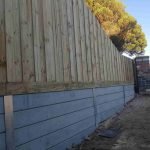Introduction
Building a maintaining wall is more than simply stacking stones or positioning lumber; it's an art that mixes engineering principles, style aesthetics, and practical performance. As we look into From Principle to Completion: A Day in the Life of a Retaining Wall Builder, you'll find the complexities associated with this fascinating occupation. Whether it's managing concrete sleepers, H beams, or wood sleepers, every element plays a pivotal role in ensuring that the structure not just looks good but also stands the test of time.
What is a Maintaining Wall?
A maintaining wall is a structure designed to hold back soil and avoid erosion on sloped surface areas. These walls are important for maintaining landscape stability and can be made from different materials such as stone, wood, and concrete.
The Function of a Retaining Wall Installer
A retaining wall installer is responsible for changing plans into tangible structures. They work closely with designers and landscape designers to ensure that the ended up item satisfies both functional and visual criteria.
Understanding the Different Types of Keeping Walls
Concrete Sleepers
Concrete sleepers are pre-cast blocks used for their toughness and resilience. They provide exceptional support for heavy loads and are resistant to rot and insect damage.
H Beams
H beams use considerable structural assistance due to their shape, making them perfect for taller keeping walls where additional strength is required.
Wood Sleepers
Though visually attractive, wood sleepers need regular upkeep due to their susceptibility to decay. Nevertheless, they can supply a warm aesthetic that mixes well with natural landscapes.
Timber Sleepers
Timber sleepers are often utilized in residential projects where less height is needed. They can develop a rustic beauty however featured issues about longevity.
Stone Keeping Walls
Stone walls are classic and can add enormous value to residential or commercial properties. Their natural appearance makes them popular in landscaping styles but needs skilled craftsmanship for appropriate installation.
The Preliminary Assessment: What Takes Place First?
During the initial consultation stage, a retaining wall contractor meets clients to discuss their needs and choices. This stage includes website evaluations, understanding drain issues, and identifying material choices.

Planning & Design Stage: Crafting the Blueprint
Once preliminary discussions conclude, in-depth blueprints are developed. This strategy includes measurements, material requirements (be it concrete sleeper or stone), and drainage solutions.
Permits & Laws: Navigating Legalities
Before building starts, protecting needed permits is crucial. Building regulations vary by location; for this reason understanding regional policies makes sure compliance throughout the project.
Preparing the Site: Cleaning & Excavation Work
Preparing the site includes cleaning plant life and debris followed by excavation work. This step lays the structure for a structurally sound keeping wall.
Material Choice: Choosing The Right Components
Selecting materials lines up closely with design goals while also considering budget restrictions. Factors like toughness (concrete vs. timber sleeper) play a necessary function in this decision-making process.
Foundation Work: The Value of Stability
A strong foundation is non-negotiable when developing any maintaining wall. Whether utilizing H beams or stone, making sure stability prevents future collapses or shifts.
Construction Process: Detailed Execution
Lay Out The Plan
Using stakes and string lines assists envision where each element will go.
Excavate For The Base
Digging down makes sure that water will drain effectively away from the wall.
Install Drain Solutions
Correct drain systems avoid soil saturation behind walls.
Constructing The Wall
Depending upon picked materials (like concrete sleepers), walls might be developed layer by layer.
Backfilling
Once set up, backfilling assists stabilize the structure while making sure adequate drainage.
Finish Work
Adding any preferred features like caps or ornamental elements finishes the look.
Tools of The Trade: Important Devices For Builders
Having a range of tools available makes all tasks simpler:
http://beaufence-installerczex638.huicopper.com/enhancing-curb-appeal-with-skillfully-crafted-maintaining-walls-by-top-builders
- Shovels & & Picks Levels Compactors Trowels Power Tools
Quality Control Procedures Throughout Construction
Quality control guarantees that every element meets market requirements:
- Regular Inspections Material Testing Adherence To Plans
Addressing Obstacles On-Site: Problem-Solving Abilities Required
No building task goes off without a drawback! From unanticipated weather condition modifications to material shortages-- being adaptable is key!
Final Touches: Aesthetic Enhancements For Your Keeping Wall
After building comes beautification:
Landscaping around it Adding plants or lighting Painting or staining wood structuresMaintenance Tips For Longevity Of Retaining Walls
To extend the life of your retaining wall:
- Regularly inspect for fractures Clean particles Check drainage systems
Common Frequently asked questions About Keeping Walls
1. What materials are best for constructing retaining walls?
Choosing between concrete sleeper, stone, timber sleeper depends on aesthetic preference and structural requirements.
2. How high can my retaining wall be?
Local regulations dictate height limitations; typically in between 4-- 6 feet without unique permits.
3. Do I require preparing permission?
In most cases yes; inspect local building codes before beginning construction.
4. Can I set up a maintaining wall myself?
While do it yourself is possible, employing experts ensures security and compliance with regulations.
5. How do I preserve my keeping wall?
Regular examinations need to concentrate on checking for fractures or drain problems; immediate repairs improve longevity!
6. Are keeping walls expensive?
Costs differ based on products picked(e.g., wood vs stone)along with labor costs involved.
Conclusion
In conclusion, building a keeping wall includes careful preparation from start to complete-- thus why comprehending every step in this journey from idea through completion matters immensely! From choosing products like concrete sleepers or wood to browsing legal requirements-- it's clear how extensive this procedure genuinely is! So next time you see one standing tall versus nature's forces-- take a minute to value all that entered into producing it!